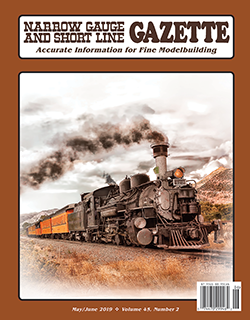 By Mike May/photos by the author except as noted
By Mike May/photos by the author except as noted
In anticipation of hauling materials for the potential construction of a major pipeline originating from Alaska’s northern oil fields, the White Pass & Yukon Railroad rebuilt a flatcar to accommodate enormous 80-foot-long sections of 56-inch diameter pipe. This flatcar was to test the feasibility of carrying such large pipe sections, but only survived a short time be-cause the pipeline was never built.
The prototype WP&Y #1191 started life as a boxcar built by the Pullman Car Company in 1942 for the Argentine State Railways, but was sold to the U.S. Navy for operations in Hawaii. At some time, individual pieces of steel plate were used to patch the car’s deck. Sold to the WP&YR in 1967, it was then cut down to be a flatcar. In 1981, with hopes high in Skagway for construction of the new pipeline, the WP&Y shops modified the car. Much of the existing car was left intact, but its frame was extended to 53 feet by adding steel to the frame and deck in the middle of the car. However the deck was never completed — only about 5 feet of new decking was added. This left about 17 feet in the middle of the car without decking.

The frame of the author’s model was constructed from styrene strips with modified HO gauge Tichy bolsters. Sparing amounts of gel styrene cement were used to tack things together before they were finally cemented with Tenax7R.
Not many records for the car are left, so much of the information for my model comes from a set of prototype drawings and photos of unmodified 1100-series cars. I have found only a handful of photos of #1191 itself, and I understand the car was only test run from Skagway to Whitehorse a few times. By 1982 hope of the pipeline construction had vanished, and #1191 sat in the Skagway yard. In 1988, #1191 was accidentally hit by a string of coaches that got away from a switch crew. The flatcar’s frame was bent in the accident; the car was soon scrapped because building a new frame would have been too expensive.
Building The Model Frame
Working with prototype drawings of #1191, and drawings and photos of other 1100-series flatcars, I made HO scale drawings. Attached to a flat surface, these drawings were used as templates to cut the center sills, end sills, and side sills from Evergreen Styrene. I also cut frame ribs from Evergreen Styrene strips. Using sparing amounts of plastic cement to tack the pieces in place, the frame was assembled inside a simple jig built on top of the templates. Once the frame was assembled, I cemented each joint again with Tenax7R to make a final bond.
I used Tichy Train Group #3069 freight car bolsters. Since these are intended for standard gauge models, they needed to be cut down to the correct length to fit squarely between the side sills of my HOn3 model of #1191. I trimmed off both ends of each bolster evenly with a knife, and then sanded them square. The tops of the bolsters were also sanded down so the whole casting was the correct height where the bolster ends joined the side sills.

The brake rigging was built from Tichy brake set parts and brass wire. The bolster’s kingpin holes have been drilled out and filled with styrene rod, then drilled again to reduce the size of the hole so they will accept Blackstone Models’ truck screws.
To add rigidity to the model, the deck of the car was made from a single piece of sheet styrene. The deck on my model is where I decided to stray from the prototype, by not having a 17-foot-long gap in the deck. So, I built a full-length deck on the car because my layout depicts the White Pass as if it had not closed, and business had grown. I also decided that had the railroad built more flatcars like this one, they would have completed the deck on #1191.
After the sheet styrene was cut to the overall dimensions of the deck, I lightly scribed its surface to represent the individual pieces of steel plate on the prototype. The dimensions of the individual pieces of steel making up the deck on the prototype car were different from one another, so I was careful to transfer those differences to my model…



